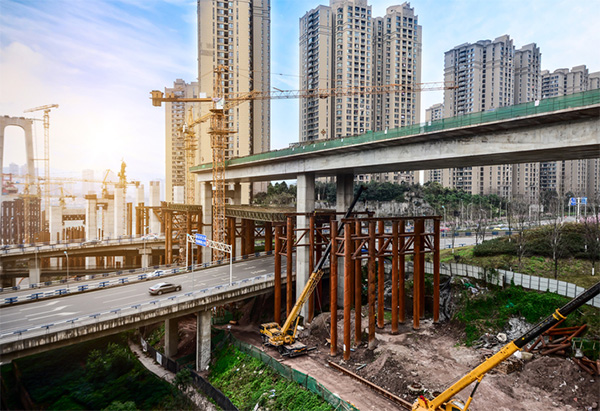‘Big, bold’ infrastructure improvements are the latest casualty of COVID-19

The on-again, off-again, on-again push for greater infrastructure spending is now off again.
Senate Majority Leader Mitch McConnell, R-Ky., put the kibosh on the latest push for what President Donald Trump once dreamed would be a “big and bold” infrastructure push during his term.
Now, it appears infrastructure has been nixed when Congress passes its next coronavirus relief package. McConnell said that $1 trillion package under consideration would be unrelated to any much smaller infrastructure improvements that might be passed before Election Day.
“We have an equal interest in doing an infrastructure bill. We don't have an equal interest in borrowing money from future generations to pay for it. In other words, it's unrelated to the coronavirus pandemic,” McConnell told Fox News.
“We need to make sure that whatever additional legislation we do is directly related to this pandemic,” the Senate majority leader told Fox.
A more modest package of infrastructure spending was passed the Senate Environment and Public Works Committee last year, but has languished since. The Democratic-led House committee in charge of infrastructure is working on a new highway bill, however. House Democratic leaders had hoped to include their $760 billion, five-year infrastructure in the next COVID-19 relief package, but that looks in jeopardy.
The current highway bill expires Sept. 30. It appears that an extension of that at current funding levels will be all that comes out this legislative session before the election.
“I think Mitch is looking at it, as I do, to an extent, as the infrastructure — he likes infrastructure. We all do,” Trump told reporters at the White House in late April. “We want to do infrastructure, but a lot of people, a lot of the Republicans, would like to keep that as a separate bill, so we'll see how that works out.”
Naturally, the big issue is how to pay for it. McConnell has warned repeatedly that he is not supportive of borrowing money to help for it – even though the government has spent approximately $4 trillion in response to the COVID-19 pandemic.
“It would take a lot of convincing to convince me that we should do transportation in a way that's not credibly paid,” Trump told The Washington Post recently.
With crude oil prices at historic lows – with futures prices even falling to a minus-$38 a barrel recently, highway advocates and others say it’s time for a modest increase in the federal fuel tax—18.4 cents a gallon on gasoline, 24.4 cents on diesel, unchanged since 1993. Except this is an election year.
A nickel-a-gallon increase in the fuel tax was one part of the U.S. Chamber of Commerce’s plan to help fund its proposal. That would raise $394 billion over the next 10 years, the Chamber said. All this would cost the average American only about $9 a month in additional gas taxes, according to the Chamber’s estimate.
Randy Mullett, a veteran Washington transportation consultant and former trucking executive, said he’s getting the same on-again, off-again signals on infrastructure.
“There are a whole lot of things that throws this into a tizzy,” Mullett told LM. “Revenue and needs are really uncertain. Even though everyone wants to get a bill done, a lot of assumptions we had 60 days ago are no longer valid.”
In fact, Mullett said, that might be for the best. “When peoples’ backs are against the wall, we tend not to make good decisions,” he said. “I just don’t think we should making decisions on a five- or six-year bill until this (coronavirus) gets resolved a bit.”
So it’s likely a continuation of the FAST Act (the current highway bill) and perhaps adding a small amount of discretionary funding for state and local governments strapped by COVID-19 funding.
“I really think they’ll do an extension, see who is in charge and see where we are after the election,” Mullett predicted. “Besides, if we’re running 30 percent less capacity on the roads, how much more capacity do we need?”
The Highway Trust Fund has been decimated by the decline in overall transport use and the decline in motor fuel taxes. According to the Eno Foundation, a Washington transportation think tank, a “best case” scenario has HTF net tax receipts for the final seven months of fiscal year 2020 dropping by $5.1 billion below the FY 2019 levels.
Here are the five Highway Trust Fund excise taxes in terms of net receipts for fiscal year 2019, totaling $43.6 billion:
- Gasoline $26,010.9 59.7%
- Diesel/special fuels $10,413.9 23.9%
- Truck/trailer sales $5,329.7 12.2%
- Heavy tires $534.6 1.2%
- Heavy vehicle use $1,285.2 2.9%
Total, Net HTF Taxes $43.6 billion 100.0%Traditional wisdom has raising any sort of tax prior to an election year is politically disastrous. With the country mired in a borderline depression because of COVID-19, any thought of raising fuel taxes at this time in an election year is folly, experts and lobbyists have said.

Article Topics
Latest in Logistics
Baltimore suing ship that crashed into bridge, closing port, costing jobs Intermodal growth volume remains intact in March, reports IANA Descartes announces acquisition of Dublin, Ireland-based Aerospace Software Developments Amid ongoing unexpected events, supply chains continue to readjust and adapt Shipment and expenditure decreases trend down, notes Cass Freight Index March trucking tonnage trends down, reports ATA FTR Shippers Conditions Index enters negative territory More LogisticsSubscribe to Logistics Management Magazine

Find out what the world's most innovative companies are doing to improve productivity in their plants and distribution centers.
Start your FREE subscription today.
April 2023 Logistics Management

Latest Resources














